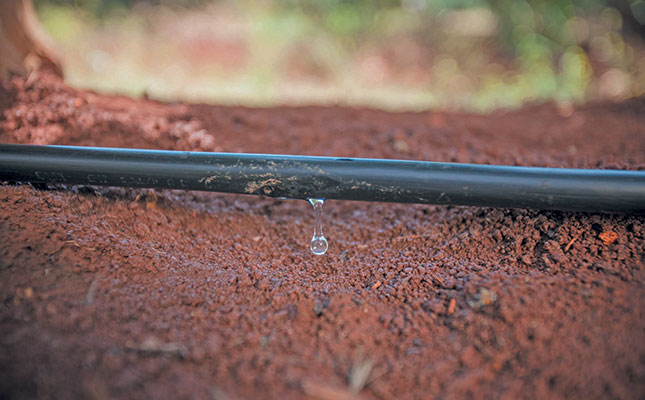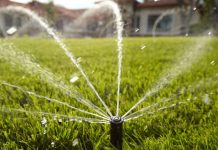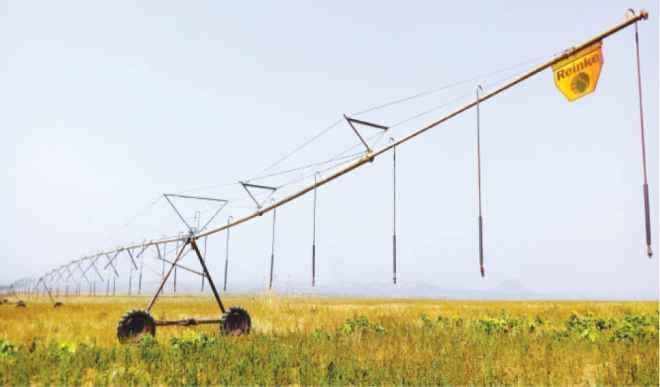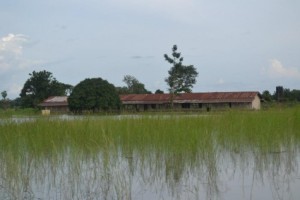Overhead irrigation is commonly used for pasture irrigation, while drip irrigation can be used for feed crops such as maize.
When water supplies are adequate, irrigation can increase crop yield dramatically. Different irrigation systems are suited to different soils, climates, crops and resources. There are three main types of irrigation systems: surface, overhead and drip (see Table 1).
Table 1
| ASPECT | SURFACE IRRIGATION | OVERHEAD IRRIGATION | DRIP IRRIGATION |
| Irrigation WUE | 55% | 75% | 90% |
| Water quality needed | Suitable for water with sediments loads too high for overhead or drip | Water quality should be potable to remain safe for people and animals | Recycled, non-potable water can be safely used |
| Soil | Not suited to highly sandy soils with high infiltration | Suited to any soils | Suited to any soils |
| Water distribution | Uniform but uncontrolled | Can be patchy | Uniform and controllable |
| Climate | Suited to areas with unlimited water and little wind | Suited to areas with unlimited water and little wind | Suited to water-limited areas, where wind may contribute to high evaporation |
| Preparation and maintenance | Little know-how required, requires labour intensive field levelling and digging | Requires know-how, little field levelling, maintenance of pipes needed | Requires know-how, no field levelling, maintenance of pipes and filtration to prevent clogging needed |
| Field shape | Any shape | Often determined by sprinkler, e.g. pivots | Any shape |
| Erosion | Soils vulnerable to floods and erosion | Soils easily eroded if water pools | Soil erosion minimized |
| Salinity | Soil salinization may occur due to capillary action drawing up salts from below to the wetted soil above | As for surface irrigation but salts may be leached out of rooting zone easier | Salinity problems may occur at wetting front if system is not flushed periodically |
| Fertilization | Not suited to fertigation | Soil can be fertigated but involves nutrient wastage | Soil can be fertigated without wastage |
| Chemicals added | No limitation on type of fertilizers and biocides | No limitation on type of fertilizers and biocides | Need to choose fertilizers and biocides that do not require surface wetting |
| Crop health | Germination generally not limited by water | Germination generally not limited by water | Germination may be limited water only occurring in the wetted area |
| Diseases | Foliage remains dry and less susceptible to fungal disease | Foliage gets wet and encourages disease in some crops | Foliage remains dry and less susceptible to fungal disease |
| Weeds | Weeds get as much water as crop | Weeds get as much water as crop | Weeds minimized as water targets crop |
| Costs | Lowest cost, initially labour intensive. | High investment costs, and relatively high labour and energy costs to maintain. | Generally has highest investment and replacement costs (plastic degrades in the sun or may be attacked by rodents), but lower labour and energy costs. |
In a dairy operation, drip irrigation is rarely used, as retrieving the dripper pipes before replanting or reploughing pasture is difficult and costly.However, small-scale dairies, where silage crops such as maize are hand-planted and harvested (as in Kenya), can save water and costs with drip irrigation.
Although expensive to install, sub-surface drip systems reduce the need to retrieve pipes, and may become more common as water becomes scarcer in South Africa.
While having the highest water- and electricity-use efficiency of any type of irrigation system, drip irrigation reduces the cost of cultivation. It limits weed growth to the wetting front, and there is none of the soil erosion associated with flood or sprinkler irrigation.





